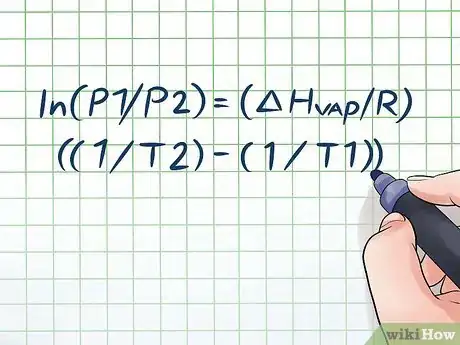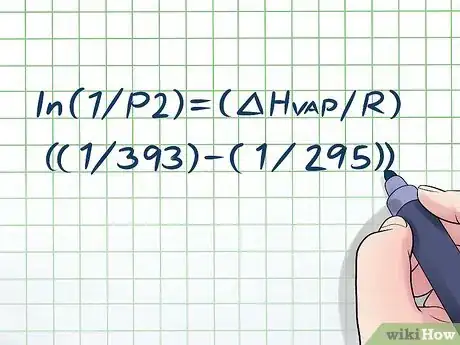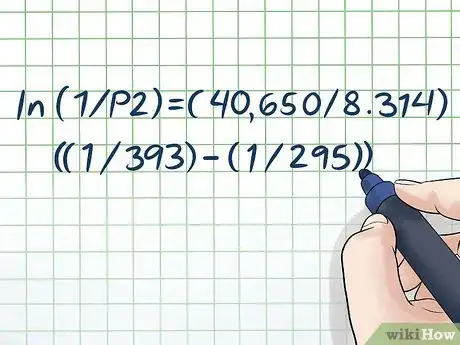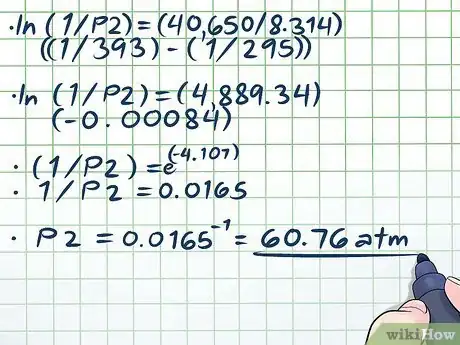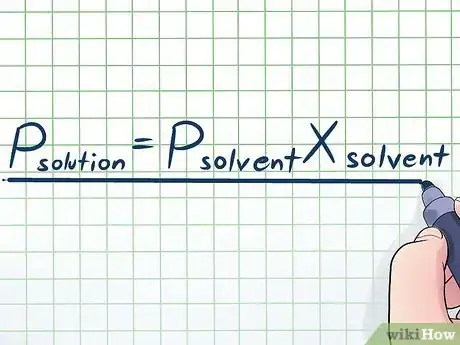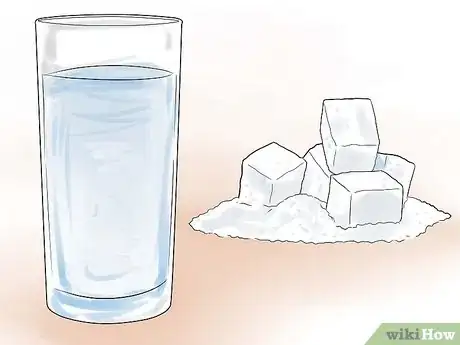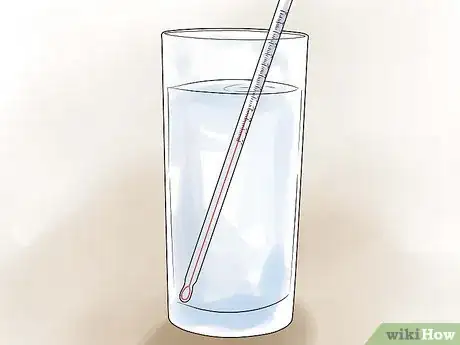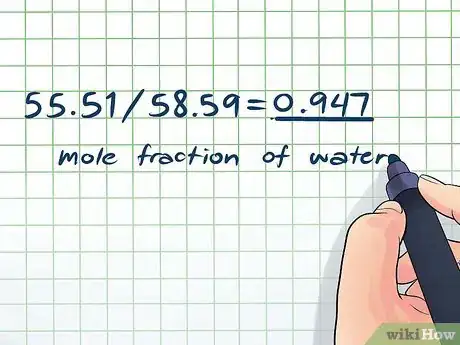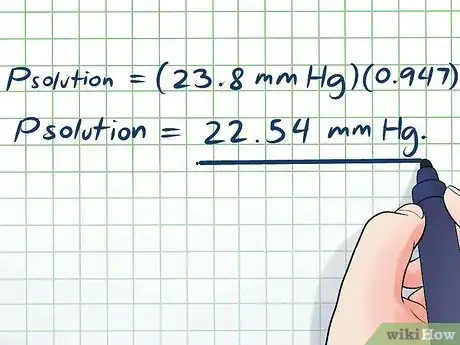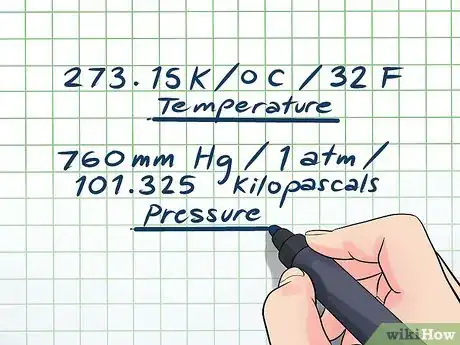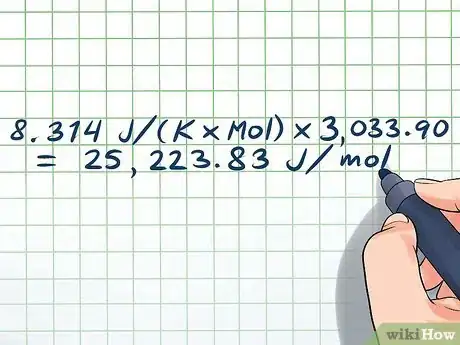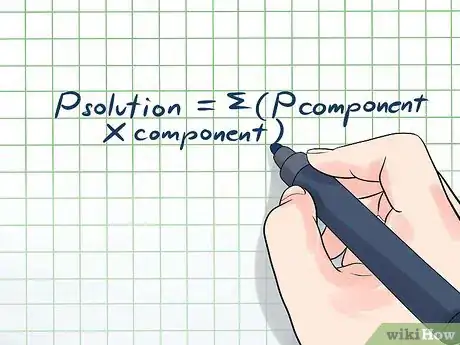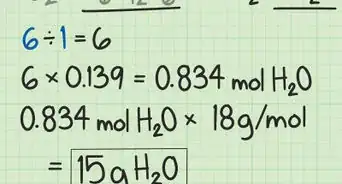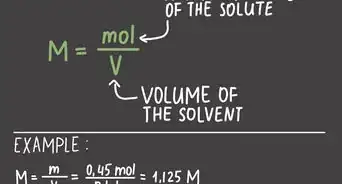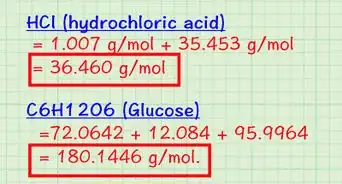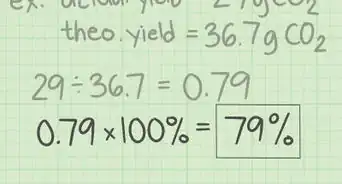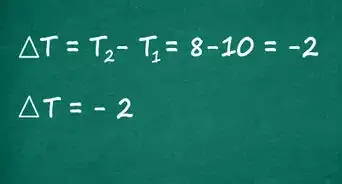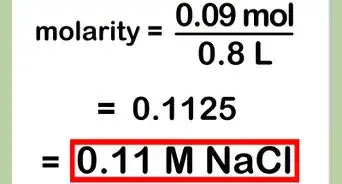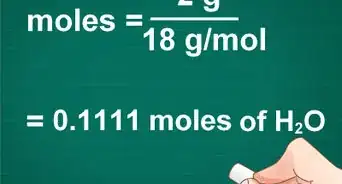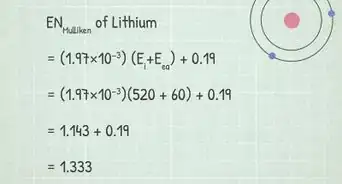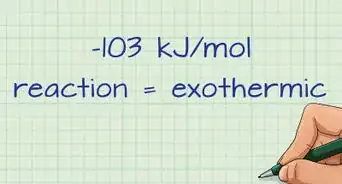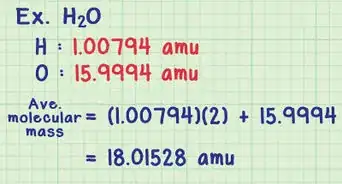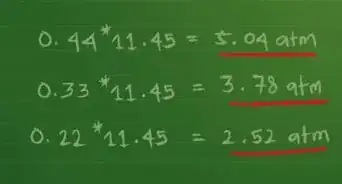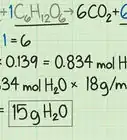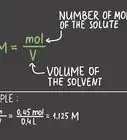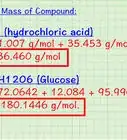This article was co-authored by Bess Ruff, MA. Bess Ruff is a Geography PhD student at Florida State University. She received her MA in Environmental Science and Management from the University of California, Santa Barbara in 2016. She has conducted survey work for marine spatial planning projects in the Caribbean and provided research support as a graduate fellow for the Sustainable Fisheries Group.
There are 10 references cited in this article, which can be found at the bottom of the page.
This article has been viewed 569,829 times.
Have you ever left a bottle of water out in the hot sun for a few hours and heard a slight "hissing" noise when you opened it? This is caused by a principle called vapor pressure. In chemistry, vapor pressure is the pressure that is exerted on the walls of a sealed container when a substance in it evaporates (converts to a gas).[1] To find the vapor pressure at a given temperature, use the Clausius-Clapeyron equation: ln(P1/P2) = (ΔHvap/R)((1/T2) - (1/T1)). You could also use Raoult's Law to find the vapor pressure: Psolution=PsolventXsolvent.
Steps
Using the Clausius-Clapeyron Equation
-
1Write the Clausius-Clapeyron equation. The formula used for calculating vapor pressure given a change in the vapor pressure over time is known as the Clausius-Clapeyron equation (named for physicists Rudolf Clausius and Benoît Paul Émile Clapeyron).[2] This is the formula you'll use to solve the most common sorts of vapor pressure problems you'll find in physics and chemistry classes. The formula looks like this: ln(P1/P2) = (ΔHvap/R)((1/T2) - (1/T1)). In this formula, the variables refer to:
- ΔHvap: The enthalpy of vaporization of the liquid. This can usually be found in a table at the back of chemistry textbooks.
- R: The real gas constant, or 8.314 J/(K × Mol).
- T1: The temperature at which the vapor pressure is known (or the starting temperature.)
- T2: The temperature at which the vapor pressure is to be found (or the final temperature.)
- P1 and P2: The vapor pressures at the temperatures T1 and T2, respectively.
-
2Plug in the variables you know. The Clausius-Clapeyron equation looks tricky because it has so many different variables, but it's actually not very difficult when you have the right information. The most basic vapor pressure problems will give you two temperature values and a pressure value or two pressure values and a temperature value — once you have these, solving is a piece of cake.
- For example, let's say that we're told that we have a container full of liquid at 295 K whose vapor pressure is 1 atmosphere (atm). Our question is: What is the vapor pressure at 393 K? We have two temperature values and a pressure, so we can solve for the other pressure value with the Clausius-Clapeyron equation. Plugging in our variables, we get ln(1/P2) = (ΔHvap/R)((1/393) - (1/295)).
- Note that, for Clausius-Clapeyron equations, you must always use Kelvin temperature values. You can use any pressure values as long as they are the same for both P1 and P2.
Advertisement -
3Plug in your constants. The Clausius-Clapeyron equation contains two constants: R and ΔHvap. R is always equal to 8.314 J/(K × Mol). ΔHvap (the enthalpy of vaporization), however, depends on the substance whose vapor pressure you are examining. As noted above, you can usually find the ΔHvap values for a huge variety of substances in the back of chemistry or physics textbooks, or else online.
- In our example, let's say that our liquid is pure liquid water. If we look in a table of ΔHvap values, we can find that the ΔHvap is roughly 40.65 kJ/mol. Since our H value uses joules, rather than kilojoules, we can convert this to 40,650 J/mol.
- Plugging our constants in to our equation, we get ln(1/P2) = (40,650/8.314)((1/393) - (1/295)).
-
4Solve the equation. Once you have all of your variables in the equation plugged in except for the one you are solving for, proceed to solve the equation according to the rules of ordinary algebra.[3]
- The only difficult part of solving our equation (ln(1/P2) = (40,650/8.314)((1/393) - (1/295))) is dealing with the natural log (ln). To cancel out a natural log, simply use both sides of the equation as the exponent for the mathematical constant e. In other words, ln(x) = 2 → eln(x) = e2 → x = e2.
- Now, let's solve our equation:
- ln(1/P2) = (40,650/8.314)((1/393) - (1/295))
- ln(1/P2) = (4,889.34)(-0.00084)
- (1/P2) = e(-4.107)
- 1/P2 = 0.0165
- P2 = 0.0165-1 = 60.76 atm. This makes sense — in a sealed container, increasing the temperature by almost 100 degrees (to almost 20 degrees over the boiling point of water) will create lots of vapor, increasing the pressure greatly
Finding Vapor Pressure with Dissolved Solutions
-
1Write Raoult's Law. In real life, it's rare to work with a single pure liquid — usually, we deal with liquids that are mixtures of several different component substances. Some of the most common of these mixtures are created by dissolving a small amount of a certain chemical called a solute in a large amount of a chemical called a solvent to create a solution. In these cases, it's useful to know an equation called Raoult's Law (named for physicist François-Marie Raoult),[4] which looks like this: Psolution=PsolventXsolvent. In this formula, the variables refer to;
- Psolution: The vapor pressure of the entire solution (all of the component parts combined)
- Psolvent: The vapor pressure of the solvent
- Xsolvent: The mole fraction of the solvent.
- Don't worry if you don't know terms like "mole fraction" — we'll explain these in the next few steps.
-
2Identify the solvent and solute in your solution. Before you calculate the vapor pressure of a mixed liquid, you need to identify the substances with which you are working. As a reminder, a solution is formed when a solute is dissolved in a solvent — the chemical that dissolves is always the solute and the chemical that does the dissolving is always the solvent.
- Let's work through a simple example in this section to illustrate the concepts we're discussing. For our example, let's say that we want to find the vapor pressure of simple syrup. Traditionally, simple syrup is one part sugar dissolved in one part water, so we'll say that sugar is our solute and water is our solvent.
- Note that the chemical formula for sucrose (table sugar) is C12H22O11. This will be important soon.
-
3Find the temperature of the solution. As we saw in the Clausius-Clapeyron section above, a liquid's temperature will affect its vapor pressure. In general, the higher the temperature, the greater the vapor pressure — as the temperature increases, more of the liquid will evaporate and form vapor, increasing the pressure in the container.[5]
- In our example, let's say that the simple syrup's current temperature is 298 K ( about 25 C).
-
4Find the solvent's vapor pressure. Chemical reference materials usually have vapor pressure values for many common substances and compounds, but these pressure values are usually only for when the substance is at 25 C/298 K or at its boiling point. If your solution is at one of these temperatures, you can use the reference value, but if not, you'll need to find the vapor pressure at its current temperature.[6]
- The Clausius-Clapeyron can help here — use the reference vapor pressure and 298 K (25 C) for P1 and T1 respectively.
- In our example, our mixture is at 25 C, so we can use our easy reference tables. We find that water at 25 C has a vapor pressure of 23.8 mm HG [7]
-
5Find the mole fraction of your solvent. The last thing we need to do before we can solve is to find the mole fraction of our solvent. Finding mole fractions is easy: just convert your components to moles, then find what percentage of the total number of moles in the substance each component occupies. In other words, each component's mole fraction equals (moles of component)/(total number of moles in the substance.)[8]
- Let's say that our recipe for simple syrup uses 1 liter (L) of water and 1 liter of sucrose (sugar.) In this case, we'll need to find the number of moles in each. To do this, we'll find the mass of each, then use the substance's molar masses to convert to moles.
- Mass (1 L of water): 1,000 grams (g)
- Mass (1 L of raw sugar): Approx. 1,056.7 g[9]
- Moles (water): 1,000 grams × 1 mol/18.015 g = 55.51 moles
- Moles (sucrose): 1,056.7 grams × 1 mol/342.2965 g = 3.08 moles (note that you can find sucrose's molar mass from its chemical formula, C12H22O11.)
- Total moles: 55.51 + 3.08 = 58.59 moles
- Mole fraction of water: 55.51/58.59 = 0.947
-
6Solve. Finally, we have everything we need to solve our Raoult's Law equation. This part is surprisingly easy: just plug your values in for the variables in the simplified Raoult's Law equation at the beginning of this section (Psolution = PsolventXsolvent).[10]
- Substituting our values, we get:
- Psolution = (23.8 mm Hg)(0.947)
- Psolution = 22.54 mm Hg. This makes sense — in mole terms, there's only a little sugar dissolved in a lot of water (even though in real-world terms the two ingredients have the same volume), so the vapor pressure will only decrease slightly.
Finding Vapor Pressure in Special Cases
-
1Be aware of Standard Temperature and Pressure conditions. Scientists frequently use a set of temperature and pressure values as a sort of convenient "default". These values are called Standard Temperature and Pressure (or STP for short). Vapor pressure problems frequently make reference to STP conditions, so it's handy to have these values memorized. STP values are defined as:[11]
- Temperature: 273.15 K / 0 C / 32 F
- Pressure: 760 mm Hg / 1 atm / 101.325 kilopascals
-
2Rearrange the Clausius-Clapeyron equation to find other variables. In our example in Section 1, we saw that the Clausius-Clapeyron equation is very useful for finding the vapor pressures of pure substances. However, not every question will ask you to find P1 or P2 — many will ask you to find a temperature value or even sometimes an ΔHvap value. Luckily, in these cases, getting the right answer is simply a matter of rearranging the equation so that the variable you're solving for is alone on one side of the equals sign.[12]
- For instance, let's say that we have an unknown liquid with a vapor pressure of 25 torr at 273 K and 150 torr at 325 K and we want to find this liquid's enthalpy of vaporization (ΔHvap). We could solve like this:
- ln(P1/P2) = (ΔHvap/R)((1/T2) - (1/T1))
- (ln(P1/P2))/((1/T2) - (1/T1)) = (ΔHvap/R)
- R × (ln(P1/P2))/((1/T2) - (1/T1)) = ΔHvap Now, we plug in our values:
- 8.314 J/(K × Mol) × (-1.79)/(-0.00059) = ΔHvap
- 8.314 J/(K × Mol) × 3,033.90 = ΔHvap = 25,223.83 J/mol
-
3Account for the vapor pressure of the solute when it produces vapor. In our Raoult's Law example above, our solute, sugar, doesn't produce any vapor on its own at normal temperatures (think — when was the last time you saw a bowl of sugar evaporate on your counter top?) However, when your solute does evaporate, this will affect your vapor pressure.[13] We account for this by using a modified version of the Raoult's Law equation: Psolution = Σ(PcomponentXcomponent) The sigma (Σ) symbol means that we just need to add up all of the different components' vapor pressures to find our answers.
- For example, let's say that we have a solution made from two chemicals: benzene and toluene. The total volume of the solution is 120 milliliters (mL); 60 mL of benzene and 60 of toluene. The temperature of the solution is 25 C and the vapor pressures of each of these chemicals at 25 C is 95.1 mm Hg for benzene 28.4 mm Hg for toluene. Given these values, find the vapor pressure of the solution. We can do this as follows, using standard density, molar mass, and vapor pressure values for our two chemicals:
- Mass (benzene): 60 mL = .060 L × 876.50 kg/1,000 L = 0.053 kg = 53 g
- Mass (toluene): .060 L × 866.90 kg/1,000 L = 0.052 kg = 52 g
- Moles (benzene): 53 g × 1 mol/78.11 g = 0.679 mol
- Moles (toluene): 52 g × 1 mol/92.14 g = 0.564 mol
- Total moles: 0.679 + 0.564 = 1.243
- Mole fraction (benzene): 0.679/1.243 = 0.546
- Mole fraction (toluene): 0.564/1.243 = 0.454
- Solve: Psolution = PbenzeneXbenzene + PtolueneXtoluene
- Psolution = (95.1 mm Hg)(0.546) + (28.4 mm Hg)(0.454)
- Psolution = 51.92 mm Hg + 12.89 mm Hg = 64.81 mm Hg
Community Q&A
-
QuestionHow is vapor pressure affected by temperature?
 Community AnswerAs the temperature of a liquid or solid increases, its vapor pressure also increases. Conversely, vapor pressure decreases as the temperature decreases.
Community AnswerAs the temperature of a liquid or solid increases, its vapor pressure also increases. Conversely, vapor pressure decreases as the temperature decreases. -
QuestionHow can I solve this problem? "The vapor pressure of pure water is 760mm at 25 degree Celsius. The vapor pressure of a solution containing 1 m of solution of glucose will be what?"
 Community AnswerI suggest you study colligative properties. The pressure lowering of the water is PX' as P stands for the pressure of pure solvent and X' is the molar fraction of the solute. 1L of water has 1000g of water, so there are 1000/18 mols of water ~ 55.6 mols. So, there's 56.6 mols of molecules for every 1L of solution (one comes from glucose and 55.6 from water as calculated). So, the solute molar fraction is 1/56.6 ~ 1.768.10^-2. So the pressure lowering is 760mmHg times 1.768.10^-2, which is ~ 13.44 mmHg. Finally, the vapor pressure of the solution is 760mmHg-13.44mmHg = 746.56mmHg.
Community AnswerI suggest you study colligative properties. The pressure lowering of the water is PX' as P stands for the pressure of pure solvent and X' is the molar fraction of the solute. 1L of water has 1000g of water, so there are 1000/18 mols of water ~ 55.6 mols. So, there's 56.6 mols of molecules for every 1L of solution (one comes from glucose and 55.6 from water as calculated). So, the solute molar fraction is 1/56.6 ~ 1.768.10^-2. So the pressure lowering is 760mmHg times 1.768.10^-2, which is ~ 13.44 mmHg. Finally, the vapor pressure of the solution is 760mmHg-13.44mmHg = 746.56mmHg. -
QuestionAt an ambient temperature, what would be the vapor pressure of water?
 Community AnswerYou can use the Antoine's equation to calculate the vapor pressure of any substance and any temperature. At an ambient pressure of 25 degrees Celsius, the vapor pressure of water is 23.8 torr.
Community AnswerYou can use the Antoine's equation to calculate the vapor pressure of any substance and any temperature. At an ambient pressure of 25 degrees Celsius, the vapor pressure of water is 23.8 torr.
References
- ↑ https://www.chem.purdue.edu/gchelp/liquids/vpress.html
- ↑ https://chem.libretexts.org/Bookshelves/Physical_and_Theoretical_Chemistry_Textbook_Maps/Supplemental_Modules_(Physical_and_Theoretical_Chemistry)/Physical_Properties_of_Matter/States_of_Matter/Phase_Transitions/Clausius-Clapeyron_Equation
- ↑ https://chemistrytalk.org/clausius-clapeyron-equation/#:~:text=The%20Clausius%2DClapeyron%20equation%20relates,log%20of%20the%20vapor%20pressure.
- ↑ http://chemwiki.ucdavis.edu/Physical_Chemistry/Physical_Properties_of_Matter/Solutions_and_Mixtures/Ideal_Solutions/Changes_In_Vapor_Pressure,_Raoult%27s_Law
- ↑ https://chem.libretexts.org/Bookshelves/Physical_and_Theoretical_Chemistry_Textbook_Maps/Supplemental_Modules_(Physical_and_Theoretical_Chemistry)/Physical_Properties_of_Matter/Solutions_and_Mixtures/Ideal_Solutions/Changes_In_Vapor_Pressure%2C_Raoult's_Law
- ↑ https://chem.libretexts.org/Bookshelves/Physical_and_Theoretical_Chemistry_Textbook_Maps/Supplemental_Modules_(Physical_and_Theoretical_Chemistry)/Physical_Properties_of_Matter/Solutions_and_Mixtures/Ideal_Solutions/Changes_In_Vapor_Pressure%2C_Raoult's_Law
- ↑ http://intro.chem.okstate.edu/1515SP01/Database/VPWater.html
- ↑ https://chem.libretexts.org/Bookshelves/Physical_and_Theoretical_Chemistry_Textbook_Maps/Supplemental_Modules_(Physical_and_Theoretical_Chemistry)/Physical_Properties_of_Matter/Solutions_and_Mixtures/Ideal_Solutions/Changes_In_Vapor_Pressure%2C_Raoult's_Law
- ↑ http://www.traditionaloven.com/culinary-arts/sugars/raw-sugar/convert-liter-l-to-gram-g-raw-sugar.html
- ↑ https://chem.libretexts.org/Bookshelves/Physical_and_Theoretical_Chemistry_Textbook_Maps/Supplemental_Modules_(Physical_and_Theoretical_Chemistry)/Physical_Properties_of_Matter/Solutions_and_Mixtures/Ideal_Solutions/Changes_In_Vapor_Pressure%2C_Raoult's_Law
- ↑ https://www.eiu.edu/eiuchem/forms/tutorial6.pdf
- ↑ https://chemistrytalk.org/clausius-clapeyron-equation/
- ↑ https://chem.libretexts.org/Bookshelves/General_Chemistry/Map%3A_General_Chemistry_(Petrucci_et_al.)/13%3A_Solutions_and_their_Physical_Properties/13.06%3A_Vapor_Pressures_of_Solutions
About This Article
To calculate vapor pressure, use the Clausius-Clapeyron equation, which includes the variables for the enthalpy of the liquid, the real gas constant, the starting and final temperatures, and the starting and final vapor pressures. Plug all of the known variables and constants into the equation, and isolate the unknown variable, which will be the pressure. Solve the equation for the pressure by following the order of operations. Be sure to label your final answer in atmospheres! For information on how to find the vapor pressure of dissolved solutions, read on!
